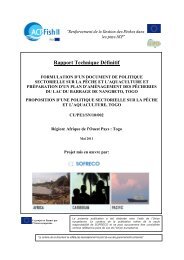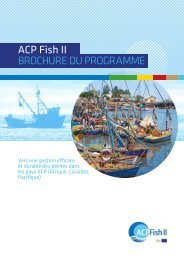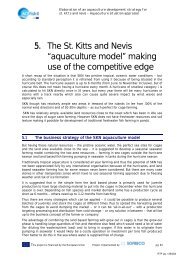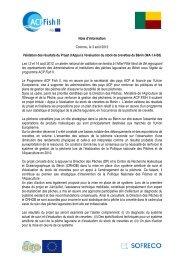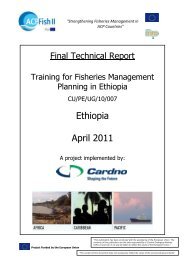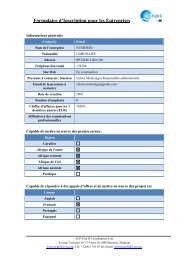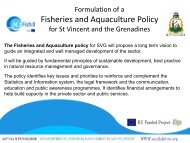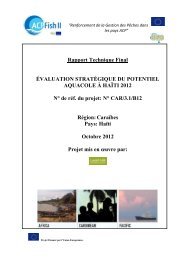Final Technical Report - ACP Fish II
Final Technical Report - ACP Fish II
Final Technical Report - ACP Fish II
You also want an ePaper? Increase the reach of your titles
YUMPU automatically turns print PDFs into web optimized ePapers that Google loves.
<strong>Final</strong> <strong>Report</strong>Megapesca Lda, Portugal7: Keeping things clean and personal hygieneRecap on importance of bacteria and reasons for hygiene (spoilage and safe food); importance ofusing clean water; how to wash and clean equipment; use of Clorox/bleach; personal hygiene (whywounds are bad, clean clothes, hand washing); hygienic facilities at landing sites (toilets, watersupply, clean floors, clean equipment); food safety risks (ready to eat foods).8: Smoking, drying and saltingWhy smoking, drying and salting preserve fish; importance of freshness of raw material; differentways of smoking fish (traditional, chorkor, cabinet), drying fish (fire, sun, solar) and salting (dry,wet) fish; calculating yield in smoked and dried fish; storage of preserved fish; prevention of lossesdue to different pests/spoilage (rats, flies, beetles, mould); packaging and storage conditions9: Investment decisions and business planning;Need for investment in businesses; different types of capital (assets and working capital);investments and returns on investment; measures of return on investment (payback period, returnon capital); working capital and cash flow management; sources of investment capital; case studyand examples of investments in small scale fish processing and selling.10: How to set up a micro-credit schemeWhat is a credit union; when and where did it start, features (interest and re-payments;organisation and management; principles of membership; assessment of applications; borrowerqualifications; secured and non-secured loans; rules on collateral; linking to external creditsources) (banks, donor funds, apex bodies etc).11: Freezing and cold storageReasons for freezing fish; freezing curve; different equipment for freezing fish (blast and platefreezers); difference between freezing and frozen storage; importance of packaging and glazing;spoilage of frozen fish (enzymes and fat rancidity); problems with frozen fish (slow freezing,high/fluctuating temperatures).12: Adding value: (processing, grading and packing)What is added value (impact on prices); different ways to add value to fish; grading by size andquality; preparing fish in different ways (gills/gutted, steaks/fillets); packaging of fish; importanceof market research (how customers use the fish); added value services (preparation).13: Marketing and selling;What is marketing; importance of regular customers and repeat purchases; difference between tradeand retail clients; how to identify and record customers; how to understand needs; how to contactcustomers; use of mobile phones and mobile money in the fish business14: How to be a trainer; communication and training techniquesFactors that need to be considered when designing training; (social background, education,experience, environment, personal motivation, resources ); setting training aims and learningobjectives for training sessions; how to plan training sessions; need to write trainers notes andchoose appropriate training aids; types of training aids used in field training (chalkboards,whiteboards, flipcharts, newsprint, flash cards, real materials & models, handouts and tips on howthey are best used); using participative methods in adult training; need for evaluation of training<strong>Technical</strong> assistance on Training of Groups of female fishmongers in good sanitary practices and management of small businesses 10





